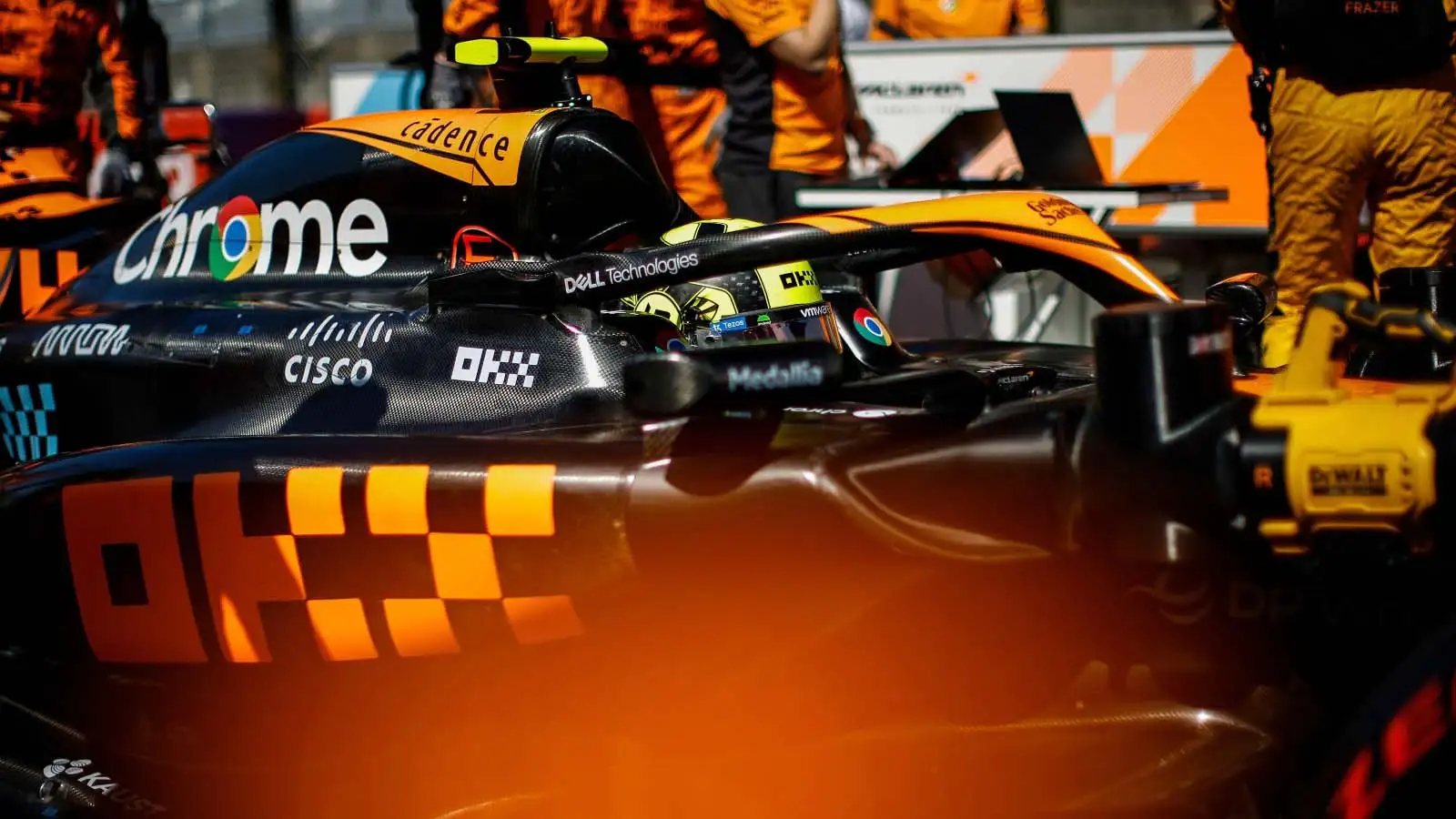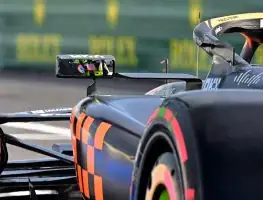Revealed: How McLaren have made one second per lap difference from Bahrain to Japan

McLaren driver Lando Norris in the team's 'stealth mode' livery at Suzuka.
In a guest appearance on the F1 Nation podcast, Andrea Stella, the McLaren team principal, discussed the significant progress his team has made this season.
When asked outright if McLaren had improved by one second per lap compared to the beginning of the season, he replied: “Based on the data we have, thanks to the developments in Austria and the updates we introduced in Singapore, along with some other minor upgrades, this roughly represents the scale of improvement throughout the season. This improvement varies depending on the track, but realistically, here [at Suzuka], to be the second-best team, you needed to be one second faster than when we were in Bahrain. So, I think the maths check out.”
Indeed, we must agree that McLaren has been the most improved team this year. Therefore, let’s take a look at their technical journey that has made them arguably the second-fastest team at present.
A start to forget for McLaren
The beginning of the 2023 season was one of the worst in the team’s history. In the first race of the season, their drivers finished in P17 and P20 – a catastrophic result for a team with high expectations.
In the following races, they slightly improved their performance, finding a better balance for their car and occasionally scoring points. However, these results were not satisfactory. Until the Austrian Grand Prix.
The Red Bull Ring was where things drastically changed. A new set of updates was introduced, one of three huge planned upgrades. Improved performance was immediately evident, with Lando Norris finishing in P4, signalling McLaren’s return to contention.
Austria updates – McLaren is back!
McLaren F1 engineers announced that they would completely change the car’s aerodynamics with these new updates. It was clear that the initial design direction for the 2023 season was off track, so much so that they planned changes to the car after pre-season testing.
Among many changes, the most notable one was a completely different geometry for sidepods and engine covers.
Second row views.#AustrianGPpic.twitter.com/TtGQoRoy0i
— McLaren (@McLarenF1)July 2, 2023
McLaren joined the trend of “waterslide” sidepods. This design, first seen on the Aston Martin car, offers several aerodynamic advantages. The indentations on the sidepods allow for better airflow towards the rear of the car, which is crucial for the efficient functioning of the car’s floor.
Improved airflow towards the rear of the car enhances the efficiency of the beam wing, a critical component this season. The beam wing works in conjunction with the car’s floor and diffuser, helping the airflow stay attached to the diffuser’s inner surface, generating more downforce.
Additionally, the “waterslide” design excels in corners. Due to the sidewall features, the airflow can be directed where it’s needed, even in turns.
Furthermore, the widened bodywork pushes the dirty air generated behind the front tyres further away from the car. This trend has been adopted by most teams due to its advantages.
Let’s not forget the change in the car’s floor introduced in Austria, which likely had an even greater impact on the car’s performance.
Post-Austria, McLaren surge forward
The results of these changes were immediately apparent. After the Austrian Grand Prix, both drivers received the updated version of the car, and the McLaren was soon seen on the podium – incredible progress in such a short time.
However, the job was not finished yet, as the team prepared further improvements for Silverstone and Hungaroring.
One of these improvements was a new front wing, complementing the car’s aerodynamic philosophy.
Nueva ala delantera en McLaren
McLaren new front wing.#f1#britishGPpic.twitter.com/UEZDawJJD6
— Albert Fabrega (@AlbertFabrega)July 7, 2023
The new front wing allowed better control and direction of airflow. Since most aerodynamic components had changed, the front wing played an even more crucial role in working together with the rest of the car.
McLaren was also one of the teams to implement an interesting design for the rear wing.
Detallea del ala trasera de McLaren
Details of McLaren's rear wingpic.twitter.com/O0ljgDbefg
— Albert Fabrega (@AlbertFabrega)August 25, 2023
Engineers managed to create this geometry while staying within the FIA rules. The main advantage of such a wing is that, with the help of edges on the endplate, two larger vortices can be created, as seen in older generations of cars.
These vortices assist by creating a low-pressure zone behind the car, effectively pulling airflow from the diffuser and helping it stay attached to the diffuser’s inner surface.
Further progress made with Singapore upgrades
After a less successful race in Italy, McLaren arrived in Singapore with the opportunity to use their new updates. Similar to Austria, much attention was drawn to the sidepods.
Aston Martin inspired downwashing waterslides now on the McLaren
They ensure consistent delivery of high energy air over the beam wing and between the tyre contact patch and diffuser resulting in consistent rear downforce for various car attitudes#SingaporeGP#F1pic.twitter.com/Uq87E6dL8h— F1_aerodynamicist (@f1_aerodynamics)September 15, 2023
“滑水”仍然存在,但没有隧道w more pronounced and deeper. Additionally, they were slightly wider, and the undercut area was larger. The undercut area is where teams sought additional clean airflow.
This trend was initiated by Red Bull and proved highly effective. The advantage of the undercut is that, if designed to keep airflow attached to the lower edge of the sidepod, it can provide a significant amount of clean air that flows beneath the suspension.
This, in turn, feeds the gap between the rear suspension and the diffuser, which is crucial in preventing dirty air from disrupting the diffuser’s airflow.
McLaren seems to have successfully incorporated this idea into their car, along with a different rear suspension setup to make the undercut area work effectively.
In Singapore, the British team also tested a new floor and a visible edge flap on the floor.
El nuevo suelo del McLaren
New McLaren's floor#f1#SingaporeGPpic.twitter.com/LQHjKoh01v
— Albert Fabrega (@AlbertFabrega)September 15, 2023
This change was inspired by previous Red Bull updates. McLaren altered the floor edge flap, extending it along the entire edge. This flap plays an interesting but useful role, creating two shedding edges that assist the vortices formed ahead of them in getting underneath the car’s floor and adding vorticity to the main vortex. This enhances the diffuser’s performance and, consequently, the downforce generated by the floor.
On circuits like Singapore and Japan, more downforce is crucial. Based on the results from these two races, it was clear that these updates were working, and the team was moving in the right direction.
PlanetF1.com建议
Revealed: The staggering cost of a modern-day Formula 1 car
F1 2023: Head-to-head qualifying and race stats between team-mates
Expecting an even stronger McLaren from here?
Although it may not be reflected in the standings, McLaren is currently performing just behind Red Bull and ahead of Mercedes, Ferrari, and Aston Martin.
With six more races to go in the season, an exciting battle is in store for the Constructors’ Championship. Given the current direction of travel, McLaren is likely to overtake Aston Martin and challenge Ferrari on pace at least, if not on points.
McLaren is on an excellent trajectory, technically and from various other perspectives. The team’s engineers are doing a great job, while the leadership is making the right decisions and guiding the team towards success.
We can only expect a better and stronger McLaren, and who knows? We may even see them competing for the championship next season.
Read next:How Oscar Piastri proved ‘special’ talent on ‘hardest track you’ll ever learn’






